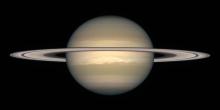Moon and Saturn [1]
All of the Sun’s major planets are a bit flattened — they’re bigger through the equator than through the poles. For Mercury and Venus, the difference is only a few miles. For Earth, it’s a few dozen miles. But for Saturn, it’s thousands of miles. Such a big difference is obvious even to the eye alone: The giant planet looks like a squashed beachball.
The planets are flattened because they’re rotating. The motion pushes material outward. Solid bodies like Earth are stiff, and they don’t rotate all that fast, so they’re not squeezed outward by much. But Saturn and the other giant worlds don’t have solid surfaces. That makes it easier to push stuff away from the center as the planet spins.
Saturn is flatter than the other giants, though. That’s largely because it’s less dense than the others. That means its surface gravity isn’t as strong, so it doesn’t grip material at the surface as tightly.
And Saturn spins in a hurry — roughly once every 10 and a half hours, although the exact timing is still uncertain. That means the planet’s equator rotates at almost 23,000 miles per hour — 20 times faster than Earth’s equator. That slings material outward with great force — making Saturn the most “squashed” planet in the solar system.
Look for Saturn near the crescent Moon early this evening. The planet looks like a bright star to the left of the Moon as twilight fades away. They set about three hours after the Sun.
Script by Damond Benningfield
Keywords:
- Saturn [3]


